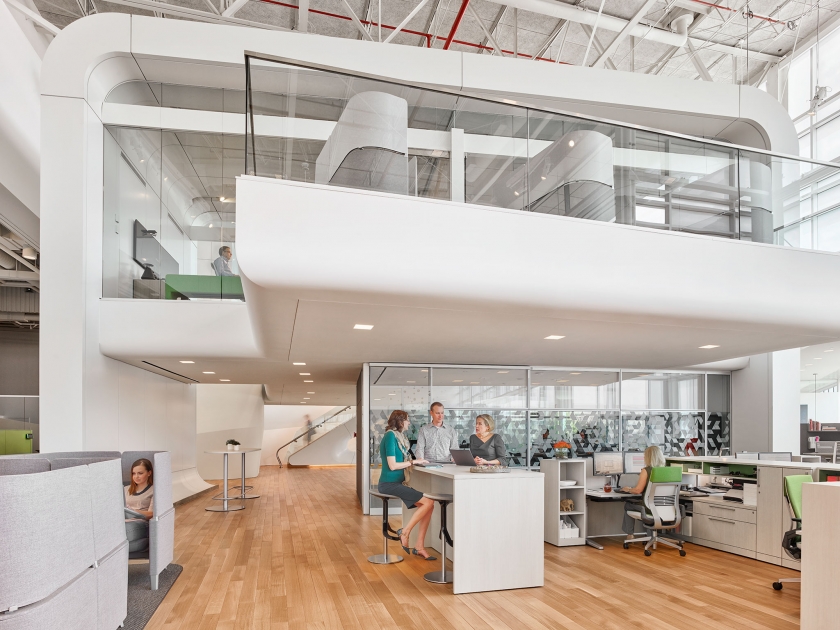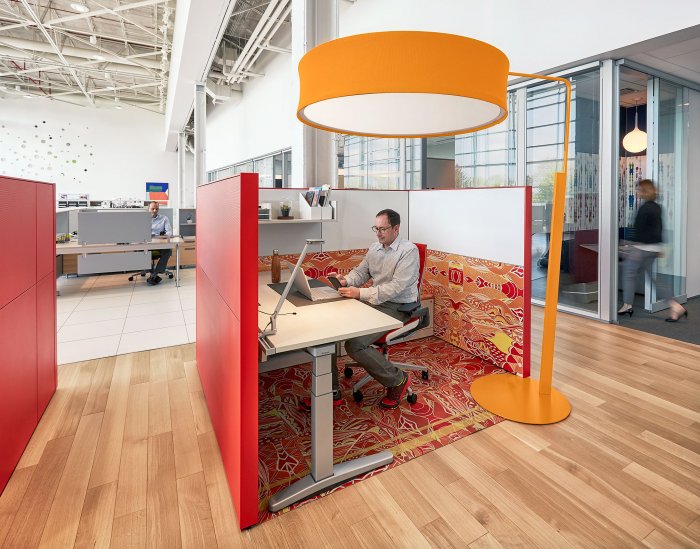
STEELCASE research reveals shift in leadership workstyles and NEW, ELEVATED CHALLENGES FOR TODAY’S EXECUTIVES
A shift in emphasis from hierarchies to networks within organizations has caused fundamental differences in the way leaders work. This new dynamic requires a dramatically different office landscape, according to new research by Steelcase.
The findings from the multinational study on the changing workstyles of leaders are particularly pertinent to the Middle East. At the recent World Government Summit H.H. Sheikh Mohammed bin Rashid Al Maktoum, Vice President and Prime Minister of the UAE and Ruler of Dubai, declared that the future of the resource-rich Arab world is dependent on strong leadership.
The two-year study on the behavior of organizational leadership identified changing workstyles and stressors leaders are facing today. While networked organizations can be more agile than traditional hierarchies, they require leaders to shift context rapidly, working on a broader range of issues than ever before, jumping from one meeting to the next. Leaders have more information to absorb and more relationships to manage. They are highly mobile, hopping time zones and always “on.” Despite these changing patterns of work, leaders continue to work in traditional ways and spaces. The Steelcase Global Report: “Engagement and the Global Workplace” found 58 percent of executives work in private offices, which put them at risk of reinforcing hierarchy and isolating them from the networks in which they need to be connected.
“Organizations are shifting to be more like complex adaptive systems, which are more agile and responsive than the hierarchies which were designed for efficiency,” said Patricia Kammer, the Steelcase senior design researcher who led the global study. "Yet, while executive suites are still the norm, leaders are spending more time working anywhere and everywhere to be in touch with what’s really happening across the organization and the globe.” The paradigm of locating executives in private offices due to confidentiality issues, Kammer notes, can inadvertently reinforce hierarchy and power structure, and potentially undermine a free-flowing exchange of ideas. It can act as an unintended barrier to leaders who want their fingers on the pulse of the organization.
In response to the research findings, Steelcase developed a radically different concept for leadership spaces from what most organizations use today: an ecosystem of spaces that support transparency and accessibility, balanced with places for privacy and confidentiality. The concept is predicated on three key principles:
- Nurture the Individual: There is a link between physical health, mental health and cognitive performance. Environments that can help executives manage stress and promote wellbeing can also enhance the cognitive process.
- Enable Transitions: Executives are challenged with the need to constantly shift informational contexts throughout the day. Physical spaces should support this need by helping leaders get into flow faster.
- Space as Synapse: Leadership spaces can be designed to help facilitate better connections between people and information, while providing remote executives with a virtual presence more similar to those leaders who are physically present in the space.
Steelcase recently built a new Leadership Community in Grand Rapids, Michigan using these principles. The space is located in a major thoroughfare for employees and can be used by the entire organization, not just senior leaders. It is considered a behavioral prototype – an environment where concepts can be tested and evaluated over time.
“There is a strong need to reassess the traditional office environment and its suitability for the demands of modern office leadership. New age leaders no longer want to feel removed from their employees, instead they are working closer together than ever before, empowering their teams to make decisions, take accountability, and develop their skills. In order for this to be possible, we must rethink the traditional workplace environment and create spaces which are conducive to integration. This is particularly true for the Middle East where we have a much younger workforce,” said xx, Steelcase.
Early data gathered from the Leadership Community indicates the space is used by the broader employee population, not just the executive staff. An important feature of the space is the zoning of its floor plan into core categories of activities: discovery and learning; collaboration and individual focusing; and connecting. Other key factors include:
- The Leadership Community is centrally located on the main floor of campus. All employees are welcome to work in the space and use it as a pathway to other areas of the office. This radical openness helps leaders improve their accessibility and organizational knowledge. It also allows for the free exchange of information and ideas, which helps build creativity and collaboration.
- The leadership team and their administrative assistants are clustered together in the Leadership Community rather than divided into silos with their teams. They each have an open plan workspace and technology is integrated throughout to accommodate remote executives. This again helps leaders improve their accessibility and organizational knowledge.
- A range of spaces, both private and public, are available for the leadership team. There are enclosed places for private conversations and meetings, as well as open spaces for socialization and relaxation, needed to help lessen executives’ cognitive burden.
Steelcase research suggests its own transition can serve as a model for executives and leadership teams around the world. For these individuals, the outcome of a transition would not only be personally beneficial to better accommodate the stress of being a leader, but would also benefit their organization as a whole, helping shape a workforce needed to succeed in today’s business climate.
About Steelcase Inc.
For over 100 years, Steelcase Inc. has helped create great experiences for the world's leading organizations, across industries. We demonstrate this through our family of brands – including Steelcase®, Coalesse®, Designtex®, PolyVision® and Turnstone®. Together, they offer a comprehensive portfolio of architecture, furniture and technology products and services designed to unlock human promise and support social, economic and environmental sustainability. We are globally accessible through a network of channels, including over 800 dealer locations. Steelcase is a global, industry-leading and publicly traded company with fiscal 2016 revenue of $3.1 billion.




























